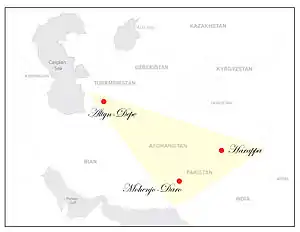Altyndepe
Altyndepe (Алтын-Депе, also sometimes Altyn Tepe, Altyn-Depe, etc. the Turkmen for "Golden Hill") is a Bronze Age (BMAC) archaeological site in Turkmenistan, near Aşgabat, inhabited first from c. 3200 to 2400 BCE in Late Regionalization Era, and next from c.2400 to 2000 BCE in the Integration Era as a full urban site. [1]

Excavations
Large-scale excavations at Altyn-depe started in 1965.
During the late chalcolithic period Altyn Depe became a large-scale center with an area of 25 hectares. It was surrounded by an adobe wall with rectangular watch towers.
Ziggurat
The site is notable for the remains of its ziggurat.[2] This was a monumental religious complex with a four-level tower of the Mesopotamian ziggurat type.[3] This construction has also been described as "proto-Zoroastrian".
There were also other Mesopotamian connections,
"The Altyn Depe civilization was in close contact with neighboring cultures. Sulfur-glazed vessels (Tepe Hissar, Tureng Tepe) obviously brought in from northeastern Iran turned up during the excavations in the aristocratic sector."[3]
Namazga V and Altyndepe were also in contact with the Late Harappan culture (ca. 2000-1600 BC). In Altyn Depe, many Indus Valley items were found, including objects made of ivory, and stamp seals of the Harappian type. At least one item contained Harappian writing.
Masson (1988) views the culture as having a Proto-Dravidian affiliation. Also, Sarianidi affiliates the site with Indo Iranians.
Two-wheeled carts
Models of two-wheeled carts from c. 3000 BC found at Altyn-Depe are the earliest complete evidence of wheeled transport in Central Asia, though model wheels have come from contexts possibly somewhat earlier. Judging by the type of harness, carts were initially pulled by oxen, or a bull. However camels were domesticated within the BMAC. A model of a cart drawn by a camel of c. 2200 BC was found at Altyn-Depe.[4]
Monjukli Depe, another important ancient settlement is located nearby.
References
- Vidale, Massimo, (2017). Treasures from the Oxus, p. 9, Table 1.
- V. M. Masson and V. I. Sarianidi, Central Asia: Turkmenia before the Achaemenids (trans. Tringham, 1972); review: Charles C. Kolb, American Anthropologist (1973), 1945-1948
- V. M. Masson, ARCHEOLOGY: Pre-Islamic Central Asia. iranicaonline.org, 1986 (updated in 2011)
- LB Kirtcho, The earliest wheeled transport in Southwestern Central Asia: new finds from Alteyn-Depe, Archaeology Ethnology and Anthropology of Eurasia, vol. 37, no. 1 (2009), pp. 25–33.
External links
| Wikivoyage has a travel guide for Altin Depe. |
